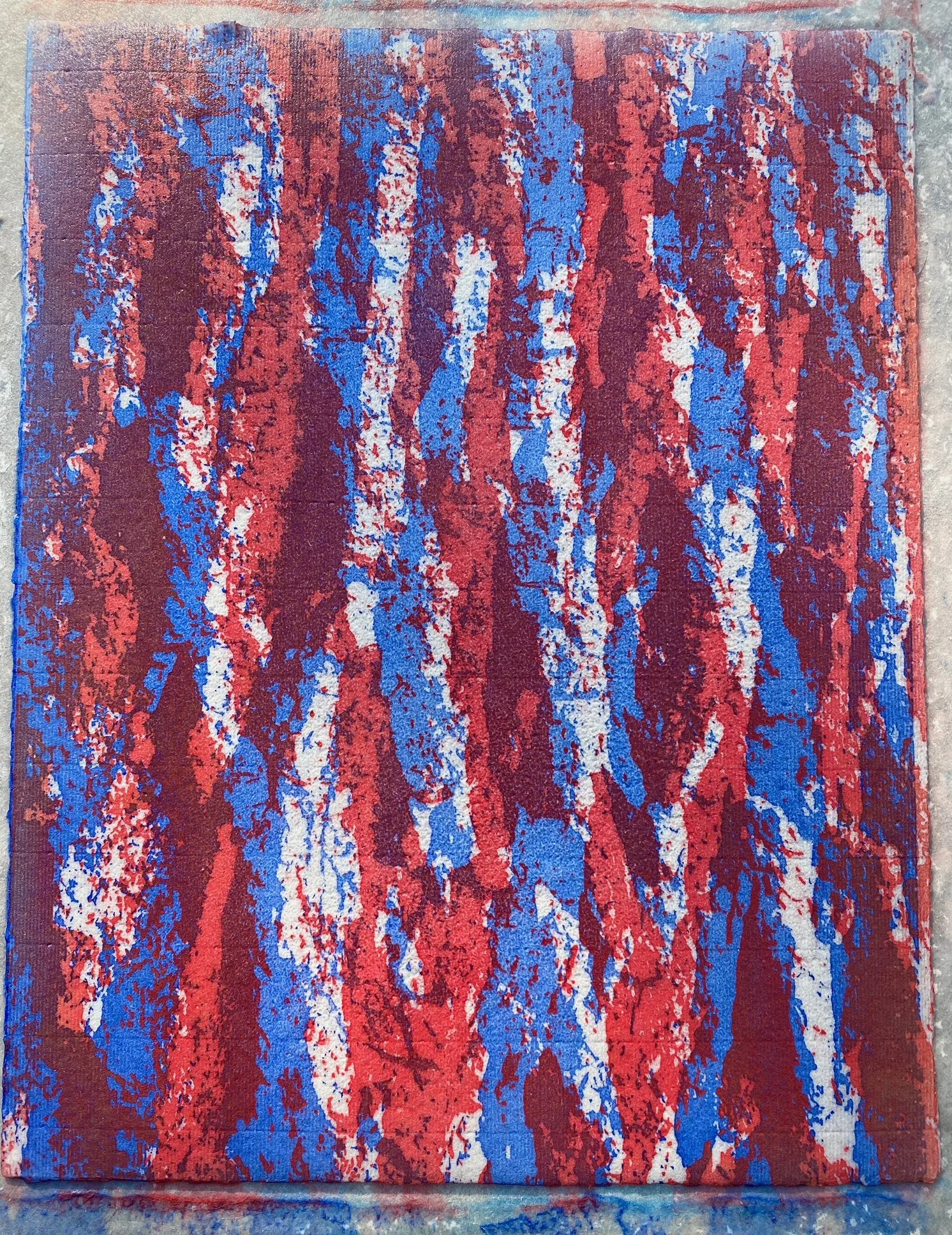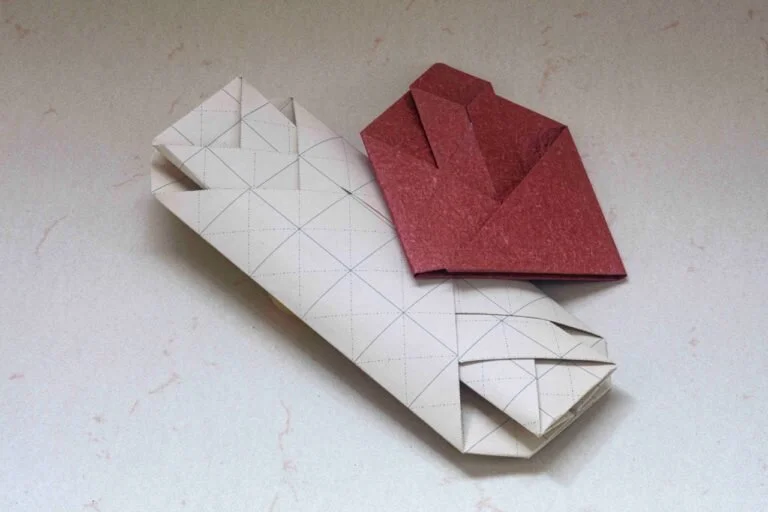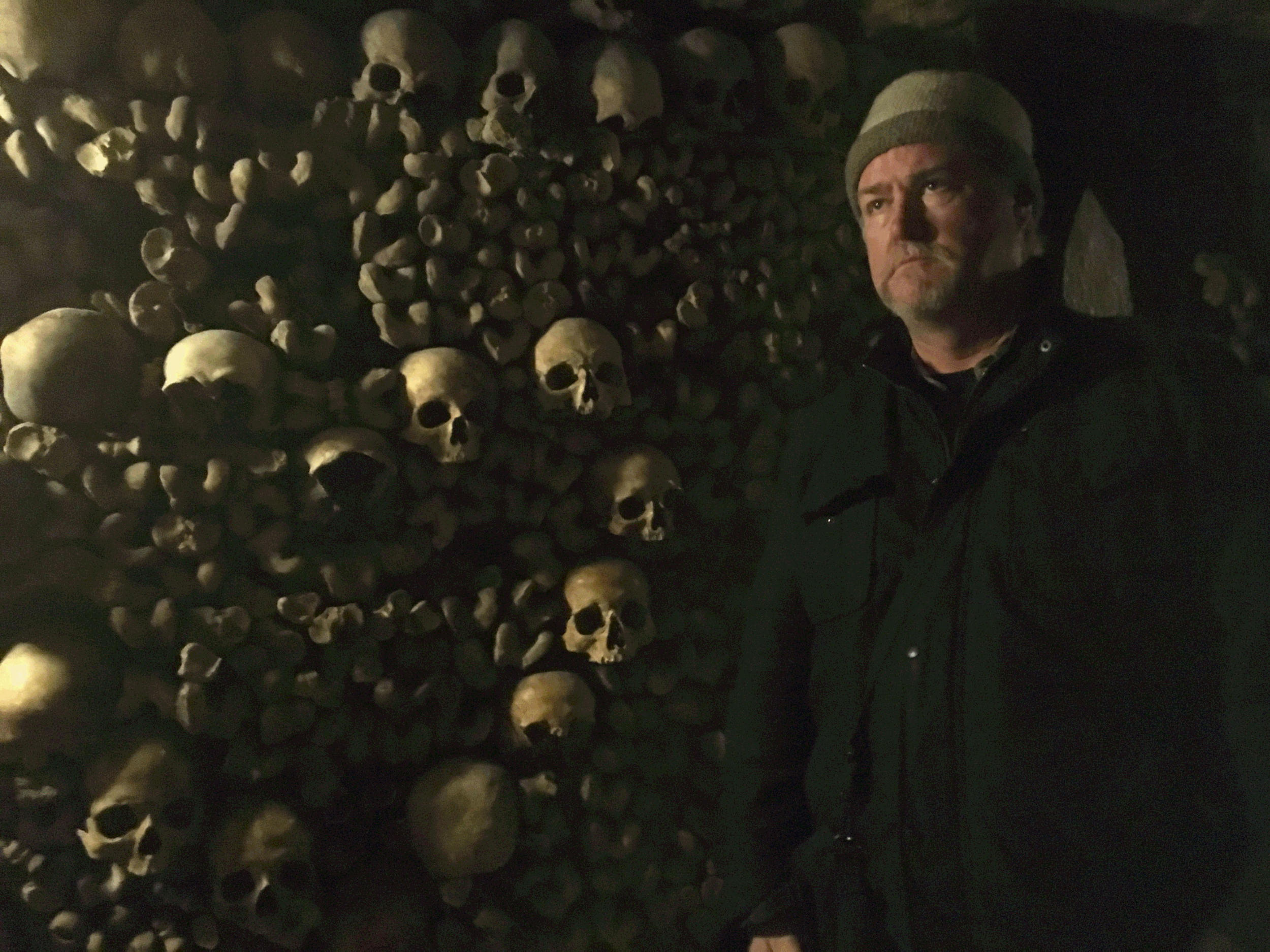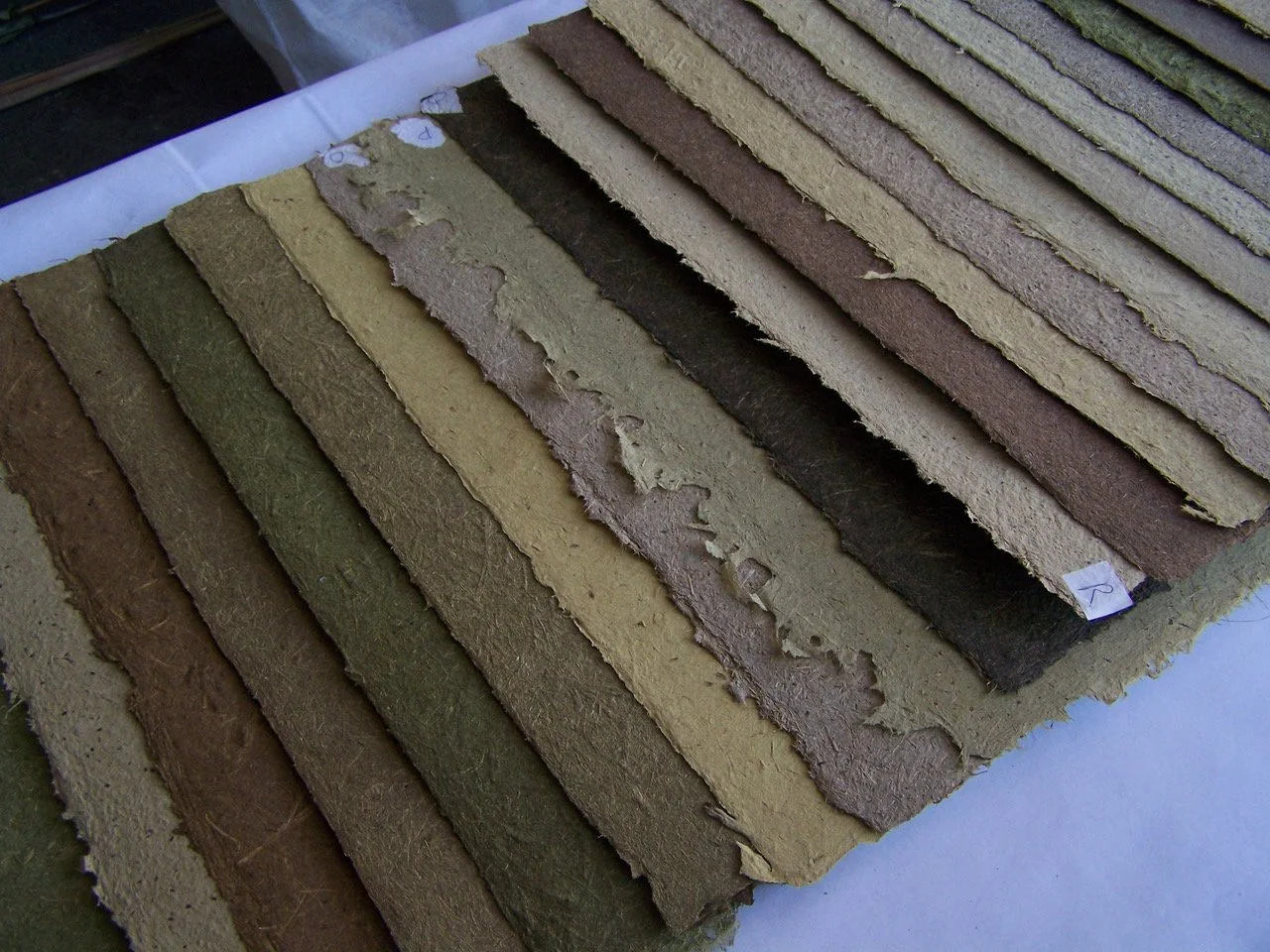Session One
Drew Cameron | Pulp Printing in Handmade Paper
Jerushia Graham | The Endless Possibilities of Papercuts
Richard Spelker | Making Ink for Writing and Drawing
Hedi Kyle & Ulla Warchol | The Art of the Fold and New Departures
Julie Smith | Think Inside the Box (and about how you will get in there)
Session Two
Jeff Altepeter | Trad/Rad Calf
Brien Beidler | Making Finishing Tools: an Economical Approach
Clay Harmon | Creative Printmaking Approaches Using Polymer Plates
Emily Martin | Paper in Motion: Getting Up Off the Page
Andrea Peterson | Papermaking: In the Field
Drew Cameron
Pulp Printing in Handmade Paper
Pulp Printing allows for finely beaten, pigmented pulp to be aerosol sprayed through a stencil, rendering detailed imagery onto freshly formed, wet sheets of handmade paper. This workshop covers techniques and process of this contemporary application in hand papermaking. The process includes how to procure correct tools, select and mix pigments, prepare effective fibers, prepare stencil screens to produce handmade paper sheets imbued with colorful pulp prints. Participants will have the opportunity to submit images in advance of the course to be made into group stencils as image selection for the workshop.
Drew Cameron is a papermaker, trained forester and former USArmy soldier. After returning from service in the war on Iraq, he cofounded Combat Paper, a vocation for military-connected communities focused on rendering handmade paper from military uniforms. This publicly supported concept has grown into several independently operated organizations which promote the enduring element of Combat Paper; teaching people to make Uniforms into Paper.
The process and those who guide people through it encourages us investigate our relationship with war, militarism and the veteran experience. The direct engagement with the people and materials from this intergenerational aspect of US society serves as forum for generating connections with people and ideas where otherwise absent.
Cameron is based in Iowa City, Iowa.
Jerushia Graham
The Endless Possibilities of Papercuts
Jerushia Graham | The Endless Possibilities of Papercuts
“The ability to simplify means to eliminate the unnecessary so that the necessary may speak.” - Hans Hofmann
“Making the simple complicated is commonplace; making the complicated simple, awesomely simple, that’s creativity.” - Charles Mingus
Papercuts are a beautiful path to simplicity of design. Great papercuts require identifying the essential elements of an image. The cuts can be created using the most basic of tools: paper, scissors, cutting mat, and exacto knife. Participants will learn about the paper cutting traditions of cultures around the world. We will create a sample book of cuts that include black line designs, white line designs, mirrored images, asymmetrical designs, multi-colored designs, and experiments with various cutting materials. This sample book will provide students with practical experience and a reference tool for future use.
Jerushia Graham is the Museum Coordinator for the Robert C. Williams Museum of Papermaking and a working artist. She is an Atlanta-based printmaker, papermaker, book artist, and fiber artist who exhibits both nationally and internationally. Graham is a member of the Book/Print Artist/Scholar of Color Collect, the Movable Book Society, and the North American Hand Papermakers. She served as the first VP of Exhibitions/Curatorial for the North American Hand Papermakers (2020-2021) She has also been a guest curator for the Zora Neale Hurston Museum in Eatonville, FL and The Hudgens Center for Art and Learning in Duluth, GA. Graham was previously the Education Director for Atlanta Printmakers Studio, a foundations professor for the University of West Georgia and the Art Institute of Atlanta-Decatur and a book arts/papermaking/print professor for Kennesaw State University. Prior to her work in Georgia she served as the Museum Director and Education Coordinator for Spiral Q, an arts and social justice non-profit in Philadelphia. Graham exhibited as one of five artists selected by the Georgia Committee for the National Museum of Women in the Arts exhibit at MOCA GA, Paper Routes: Women to Watch 2020. Her papercuts have traveled the state of Georgia in an exhibition sponsored by the Georgia Museum of Art and Lyndon House Museum, Highlighting Contemporary Art in Georgia: Cut and Paste. She is an alumnus of The Creatives Project artist residency, the 40th St. AIR program, Experimental Printmaking Institute internship, African American Museum of Philadelphia work study, and The Fabric Workshop and Museum apprenticeship program. She earned an MFA in Book Arts/Printmaking from the University of the Arts in Philadelphia, PA, and BFA degrees in Fabric Design and Printmaking from the University of Georgia in Athens. She was born in Fort Jackson, South Carolina and grew up on military bases in Kansas, Germany, North Carolina, and Georgia. Jerushia has taught papermaking for Arrowmont (2022) and is slated to serve as a studio assistant for Nicholas Silberg’s Letterpress course at Penland in 2023. She will be in residency at Halden Bookworks in Tistedal, Norway in 2024. Graham is interested in creating spaces for empathy and socially-minded introspection through her artwork, workshops, and curatorial projects.
https://jerushiagraham.wixsite.com/jerushiagraham
Hedi Kyle & Ulla Warchol
The Art of the Fold and New Departures
This course is taught by mother and daughter, Hedi Kyle and Ulla Warchol, co-authors of The Art of the Fold, Laurence King Publishing, 2018—a step-by-step guide to making a broad selection of Hedi’s original book structures.
“In the course of writing our book—and after hundreds of hours of folding, trying to capture the sequences with diagrams and text—it became obvious to us how networks of folds relate to each other and how they can be extended and modified, leading to a range of different outcomes. In this workshop we will explore the folding patterns chosen for the book as well as new discoveries / departures that capture ideas that came to us after we had made our selection of objects and structures shared in the book.
The interaction of mountain and valley folds is essential to the transformation of the flat surface into a three-dimensional structure as they allow the folded object to be manipulated in various ways, including in its collapsed state. Once our sculptural forms emerge, we will experiment with surface treatments applied to areas that reveal themselves. Through painting, writing, stenciling, drawing, collage, etc. we will add content, turning each folded object into a unique piece.”
This course will also explore the limits and possibilities of the fold when using different papers, a broad selection of which will be provided. In addition to an array of finished pieces, participants will create a sample kit of foundational fold combinations for future reference.
Hedi Kyle is a pioneer in the field of book arts. As head conservator at the American Philosophical Society in Philadelphia, and as an adjunct professor in the Graduate Program for Book Arts and Printmaking at the University of the Arts, she has trained and mentored a generation of conservators and book artists. Her one-of-a-kind book constructions such as the Flag Book, the Blizzard Structure, and the Fishbone Fold are widely known. Hedi is an honorary member of the Guild of Book Workers and a co-founder, with Gary Frost and Tim Barrett, of the Paper & Book Intensive (PBI). She is the recipient of the 2016 Distinguished Career Award from the College Book Art Association (CBAA).
Today Hedi lives with her husband in the mountains of the Catskills, in upstate New York, where she continues to explore and experiment with the hidden potential of form and materials.
Ulla Warchol trained as an architect at the Cooper Union in the 1980’s, and while working in the field, developed a multidisciplinary approach to structure. Her work is characterized by an open-ended exploration of materials and techniques in both large-scale works—interiors, buildings, and set design—and small-scale works—books, fabrication, and collaborations with artists. Ulla was the cofounder with Claire Weisz of Weisz + Warchol, an architectural firm located in New York City. She has been a guest lecturer at Pratt Institute, the Parsons School of Design, the City College of New York, and the University of California, Davis. Ulla currently resides in Bucks County, Pennsylvania, where she splits her time between her paper studio, her woodshop, and her garden.
Instagram: @theartofthefold
Julie Smith
Think Inside the Box (and about how you will get in there)
Often in critiques or reviews of student work I’ll see a beautiful piece that does not lend itself to being shelved and immediately think “How does it want to live in the world?” And, almost always, my next thought is “You could make a really nice box for that.”
Using housing to control how a viewer comes to a piece of work or a collection of objects can be a powerful tool for setting a mood, adjusting the pace and sequence in which one encounters the work, and generally providing direction on how to approach a piece. Choosing the right box structure and closure can be a challenge, an opportunity with so much potential. The best boxes bring a kind of joy all on their own.
We’ll cover basic box construction and covering techniques and then focus on closures—from buttons, snaps, and straps to magnets and sliding doors. We’ll talk about unconventional openings and experiment with materials and coverings that will expand your options when designing enclosures for particular purposes
Julie Smith is a bookbinder and box maker based in Iowa City. She has been teaching as adjunct faculty at the University of Iowa Center for the Book for the past 14 years and takes on occasional edition work. She is currently a conservation assistant at the University Library, overseeing the repair of circulating materials for the main library and seven branch libraries. She got her start in book work at the Newberry Library, first working in Special Collections and then the Conservation Lab. A community book art class at Columbia College inspired a move to Iowa City for the Center for the Book and she couldn’t bear to leave. When work is busy and she needs a break, she treats herself and makes boxes for the library’s miniature book collection or Dada archives. Or scarves and passports for stuffed animals. There is nothing she loves more than a well-designed and executed box. Or dogs. Or night swimming. Except maybe PBI.
Richard Spelker
Making Ink for Writing and Drawing.
In this workshop, participants will learn and discuss what will make good ink for writing and drawing. We will then draw on several recipes from history and make inks ranging from black iron gall to purple logwood to indigo blue to cochineal red inks. Participants will then have the knowledge to expand further into the craft and science of making ink with their own modifications.
Richard Spelker is an independent researcher who has been studying the history of artist materials for over 25 years. He has collected over 1000 historical writing ink recipes from ancient to modern times. His research involves characterizing and adapting recipes for artistic use today. He has given many ink making classes over the years, including at the San Francisco Friends of Calligraphy, The San Francisco Center for the Book and the national Paper and Book Intensive. He has a BFA from the University of Minnesota in studio arts and art history.
Session 1
Session 2
Jeff Altepeter
Trad/Rad Calf
This class has an additional $40 studio fee.
The decoration of calfskin will be the focus of this workshop. Participants may attempt to replicate a binding in a Trad style and/or simply take inspiration from the historic recipes and techniques to develop their own Rad creations.
Working on a series of plaquettes students will experiment and practice using organic dyes and chemical reactions based on 18th and 19th century recipes. Sprinkled, speckled, marbled, mottled… undyed calf will be transformed. We will use stencils to create classic panel designs such as “Cambridge Calf” or for more adventurous motifs. A focus on the use of salts of tartar, copperas and dilute acids will provide an opportunity to discuss the controversial nature of some of these techniques. Are they appropriate for period style rebinding? Why do they sometimes degrade badly while there are also many bindings still in good condition?
The foundation for our finished model will be an 18th century-style calfskin binding. Leather paring and covering, edge coloring, and blind tooling will be some of the additional aspects of this workshop. Options will vary to allow for all skill levels to participate.
Jeffrey Altepeter has been the Bookbinding Department Head at North Bennet Street School since 2007. He is an alumnus of NBSS as well as the American Academy of Bookbinding. As a full-time bookbinding instructor, he makes and use models of historic book structures—most often to understand the history of the craft; to gain an understanding of the functional differences between various structures: and to learn how to use the tools and materials. Recently he has worked on multiple projects that require replicas of historic bindings where the aesthetics have been a focal point. The use of traditional recipes and techniques provide the most authentic look. Jeff makes specialty bindings and boxes for a wide range of institutional and individual clients.
Brien Beidler
Making Finishing Tools: an Economical Approach
Students in this workshop will learn the skills needed to fashion their own custom finishing tools. For centuries, the primary way to finish or decorate a covered binding was to build up patterns and designs with an assortment of small decorative stamps set in wooden handles. Though primarily used on leather bindings, these tools can be used on cloth, paper, and even wood.
Beginning with brass stock, students will cut, file, drill, and engrave an array of tools to suit their own aesthetics and binding needs. They will learn to durably mount their newly cut tools into wooden handles. Thermodynamic considerations and tool blank fabrication options will also be discussed.
Finishing tools are expensive and difficult to find, so being able to make one’s own is an asset to any binder. In addition to potential savings, there is the added advantage of having a unique and personal catalog of tools. We will focus on developing tool designs that can be repeated in interesting ways to build up a variety of patterns.
Be prepared for a lot of hand filing of metal.
Brien Beidler is a bookbinder and toolmaker. From the beginning, Brien has been inspired by the structure and design of historic bindings and in his work, he seeks ways to create new compositions and syntheses from these historic precedents. He also cuts, carves, and engraves an assortment of finishing and other specialized hand tools for bookbinding and its related trades.
Over the last 10 years Brien has taken and taught a variety of bookbinding and toolmaking workshops and is an active member of the Guild of Book Workers. In the fall of 2016, he and his wife upped their roots in Charleston, South Carolina and set up shop in Bloomington, Indiana, where Brien works from his home studio with Wren, his curmudgeonly pup dog.
Clay Harmon
Creative Printmaking Approaches Using Polymer Plates
This is an additional $40 studio fee for this course.
In the four days of this course, participants will learn how to use commercial steel-backed polymer plates for use in relief and intaglio printing; working with continuous tone images and making photo-gravure prints from these plates. Polymer plates are a useful addition to the toolbox of book artists due to their durability, ease of use and low-environmental-impact processing needs.
This course will cover everything from the composition of the plates to the appropriate exposure, processing and printing. Students will learn the wonder of making your own perfect relief negatives using the QuadTone RIP driver, scanning techniques and tips, making plates from digital photos and scanned artwork, and how to best expose and process polymer plates. Finally, we will touch on techniques such as chine-colle, a la poupee, and printing on non-standard substrates.
Clay Harmon is a print artist living in Asheville, North Carolina. A geophysicist by training and vocation, he has been making photographic art since the seventies. He became interested in 19th century printing processes in the nineties and has mastered platinum/palladium printing, gum bichromate and polymer photogravure.
His affinity for geometry expresses itself in his artistic interest in a photographic exploration of urban architecture. He has always been fascinated by things that hide in plain sight. The accidental and unintentional combination of architectural geometry and light found in mundane locations such as urban parking garages has been a fertile and unexpected muse for the last fifteen years.
In 2018, Clay wrote the book “Polymer Photogravure A Step-by-Step Manual Highlighting Artists and Their Creative Practice” which was published under the Focal Press imprint of Routledge Publishing. The book is a comprehensive guide to using polymer plates to create continuous-tone photogravure prints.
Emily Martin
Paper in Motion:
Getting Up Off the Page
Movable devices in books have had a job to do from the very start. As early as the 14th century, these devices helped the viewer calculate religious holidays with a volvelle or go on a pilgrimage with lift flaps, and in later times they were used for scientific and educational purposes. Paper engineering can play a primary role in the presentation of content to the reader. In this session, participants will explore various moveable devices and structures, while considering how to make use of these techniques in their own work. A variety of movable, sculptural, pop-up and dimensional possibilities such as wheels, flexagons, flaps, pull-tabs, pop-ups, tunnels, and other aspects of paper engineering will be presented. The emphasis will be on experimentation and creating models rather than finished products. We will also view examples of pop-up and movable artists’ books. While some experience with paper engineering will be helpful, all skill levels will be able to participate.
Emily Martin has been exploring the relationship between format and content for many years. She often combines letterpress printed images and text with movable and/or sculptural book forms using a variety of traditional and experimental techniques. She has held artist’s residencies at the Center for Book Arts, New York City (2002); Lawrence University (2012), the Penland School of Crafts (2014), The University of Florida, Gainesville (2015); and most recently was printer in residence at the Bodleian Libraries in Oxford, England (2018). She teaches bookbinding and paper engineering classes at the University of Iowa Center for the Book and has taught many workshops across the United States, in England, and In Chile. She received a silver medal from the Designer Bookbinders for her book The Tragedy of Romeo and Juliet (2012), and her book The Tragedy of King Lear was a semi-finalist for the Minnesota Center for Book Arts Artists Book award (2020). Her work is in collections world-wide including The Library of Congress, The Metropolitan Museum of Art, The National Library in the Victoria & Albert Museum, and the National Gallery in Washington, DC.
Andrea Peterson
Papermaking: In the Field
As we see our world changing dramatically before our eyes in ways we have never imagined, there is a wish to think about the future in a positive way – a sustainable way. Together we will learn how to be sustainable within your creative adventures.
This papermaking workshop is geared toward using a renewable fuel source, fiber sources (some organic) that are by-products of local farms, and traditional ideas in a contemporary sense while exploring a wide range of plant fiber options. The plant fibers range from garlic leaf, sisal, hay, to wheat straw. Topics covered include the selection and gathering of fibers and the use of dry versus freshly cut fiber from the field; in cooking, precook considerations, use of caustics, water concerns, and rinsing; discussion of beating options, pigmenting, sheet forming and drying. After papers are dried, we’ll explore fold strength and surface treatments to fully understand each fiber’s capability as finished paper. This physically active workshop will include prepping plant fiber by hand and cooking fiber over a wood fire.
Andrea Peterson, internationally exhibiting artist and educator, co-owns with her husband Hook Pottery Paper in northwest Indiana. Her work is multifaceted exploring all types of paper fibers and processes and includes prints, artist books, and environmental installation pieces. She received her BFA at School of the Art Institute of Chicago and her MFA in printmaking from U of MN in Minneapolis. She has lectured and taught extensively including at Ox-Bow, School of the Art Institute of Chicago, Sciola de Graphica, Venice, Italy, Paper Museum Steyermeuhl, Austria, Syracuse University and Indiana University. You can find her work in several private and corporate collections and most recently The Metropolitan Museum of Art.









